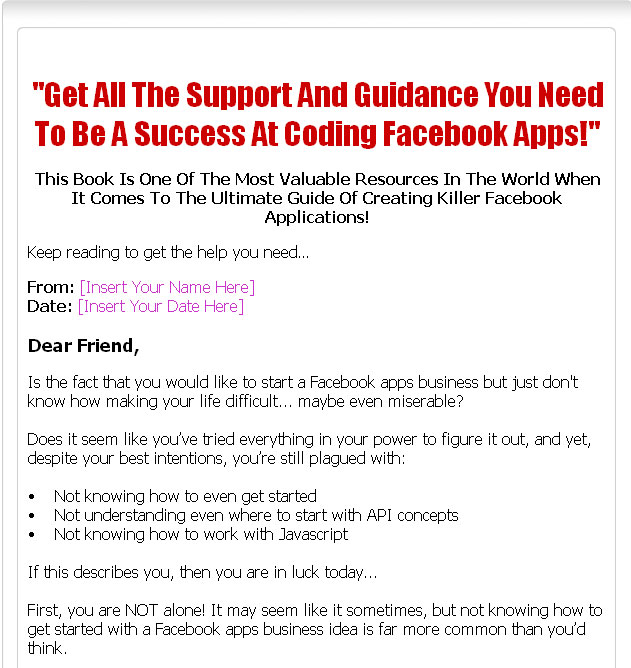Salespage Snapshot:

Table Of Contents
Foreword
Chapter 1: Introduction To Facebook Apps
Chapter 2: Exploring Facebook API
Chapter 3: Discovering Facebook Markup Language
Chapter 4: Understanding Facebook Query Language
Chapter 5: Working With Facebook Java Script
Chapter 6: Creating Apps Working On Fan Pages & Profile Pages
Chapter 7: Integrating Apps On Newsfeeds And Notifications
Chapter 8: Register Your Applications On Facebook
Chapter 9: Optimizing Facebook Applications
Chapter 10: Expand your Facebook Apps To Mobile
Wrapping Up
Sample Content Preview
Chapter 2: Exploring Facebook API
Synopsis
To begin with an API, you have to have an API key. To get this key, you have to create an application, select an application name and agree to the terms of use on the developer’s application page. Once you have done this you will be assigned an API key and a secret key.
All About API
To start coding, use FQL also known as Facebook Query Language to allow you to extract data from Facebook. The data extracted can only be obtained from users who share their information with everyone.
To improve on Graph API and to make it easier to write apps, use the Graph API Explorer. This app will make it easy to get started with the Graph API and test the API as you build your app. The Explorer can help you to do the following:
• Make requests and see formatted results in-line from the Graph API
• Explore connections of objects and field descriptions to help you understand what the response means
• Easily obtain permission necessary to access the data you need to optimize your app for users.
• It is easy to switch between HTTP, GET, POST and DELETE to get, update, create or delete objects.
• Easy to move between objects in the graph by clicking their id in the formatted result.
The Explorer is simply an application built on Facebook platform that uses the Graph API with the permissions you grant it to help you explore connections and objects in the graph.
Chapter 3: Discovering Facebook Markup Language
Synopsis
FBML also known as Facebook Markup Language is Facebook’s version of the HTML language used on the internet. There are some exceptions of the tags used in FBML and they are HTML, HEAD, BODY and Javascript.
Try New Things
It has been reported that FBML will no longer function as of June 1, 2012. Developers are encouraged to develop new applications using HTML, Javascript and CSS.
HTML – is the abbreviation for Hyper Text Markup Language. HTML is the main markup language for web pages. HTML is written using HTML elements consisting of tags enclosed in angle brackets within the web page content. The tags usually come in pairs h1 and /h1 with some exceptions like . The opening tag in the pair is called the start tag and the closing tag is the end tag. In between these tags, developers can add text, comments, tags and other text-based content.
Javascript – is a prototype-based scripting language. It is dynamic with first class functions. It is a language that supports object-oriented, imperative and functional programming styles. It is implemented as part of a web browser to provide enhanced user interfaces and dynamic websites. It is also used outside of web pages in PDF documents, site-specific browsers and desktop widgets. Javascript uses syntax influenced by C and copies many naming conventions from Java but the two languages are unrelated. Javascript’s key design principles are taken from Self and Scheme programming languages.
CSS – it stands for Cascading Style Sheets. CSS was created by the World Wide Web Consortium (W3C) to solve the problem of developers using HTML when they needed to add fonts and color to large web sites. In the latest HTML 4.0, all formatting could be removed from the HTML document and stored in a separate CSS file. All browsers support CSS today.
Chapter 4: Understanding Facebook Query Language
Synopsis
FQL also known as Facebook Query Language is Facebook’s version of SQL also known as Structured Query Language, which is widely used on the internet. FQL is a query language that allows users to query other user’s data by using a SQL-style interface, thus avoiding the need to use the Facebook Platform Graph API. Data returned from an FQL query is in a format called JSON.
Understanding Queries
Queries uses tags like SELECT, FROM, WHERE and for subqueries that use the IN keyword. All queries must also be indexable. That means that it queries properties that are marked as indexable. Indexed properties make querying faster and easier. That means that any request made will return the data queried at a faster speed than normal.
Multi-query is a series of FQL queries in one that returns the data at one time. This type of query uses the JSON structure where individual queries use the exact same syntax as a simple query and allows for more complex queries to be made. You can fetch data and use it in another query within the same request.
FQL like SQL, can also handle simple math, basic Boolean operators, AND or NOT logical operators, and ORDER BY and LIMIT clauses.
The use of FQL has the following advantages.
• Bandwidth costs are reduced because you only get the fields you asked for. Less data downloaded, less cost.
• More complex queries allowed will reduce the number of requests. This is convenient for users as they like fast and easy browsing.
• Unified interface that is consistent
• It’s easy and fun
- 1 Article (DOC)
- 1 Ebook (DOCX, PDF), 29 Pages
- 1 Lead Magnet Report (DOC, PDF), 11 Pages
- 1 Autoresponder Email Messages (TXT)
- 1 Salespage (HTML)
- Ecover (JPG)
- File Size: 35,571 KB














